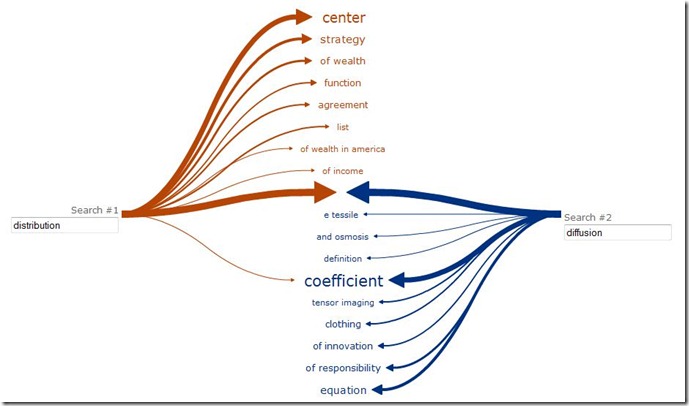A blog about Knowledge on the Web, on Web technologies, movements, philosophies and realities, on Knowledge Management and various facets of Knowledge.
05 November 2011
Technology x.0: Nowadays Frustrations of Software, Devices and Services – The PDF Editor for Tablets
Two years ago or so I bought a Digital Book Reader from Sony (Sony PRS-700BC), I founded it great at those times especially because it allowed me to annotate, highlight, extract and review the extracted text from a document (See Finally the Digital Book Reader). Unfortunately the functionality was not scaling good with documents’ size, waiting sometimes for half a minute until the change was made and I could continue to read. In some cases, I was spending more time on waits than on reading. In addition the display of formulas and images was quite problematical, being almost impossible to read a technical book. And then appeared the tablet…
I found iPad a little too expensive for my reading needs, so I waited until Toshiba’s Folio 100 appeared on the market, almost in anonymity. It was much cheaper than the iPad, was having a 10.1 inch widescreen display, relatively a small weight, and thus ideal for reading. In addition, the future support for Flash made it a good candidate for watching video learning content, another of my request. In three words: I loved it (and I still do). When I started to use it, I was kind of disappointed, because in came only with FBReaderJ reader, too limited for my needs and useless for my small electronic library mainly composed of PDF, DJVU and DOC files. After a short visit in Toshiba Market Place available through my tablet’s application, I bought myself, for small money, Documents To Go from DataViz Inc, a Software for viewing and editing of Microsoft Office 2007 documents, and for viewing PDF documents. A few months later I discovered in the same store the Office Suite Pro from MobiSystems, which provided almost same functionality as Documents To Go, with a plus for PDF viewer because it kept track of the page I was last time viewing and the scrolling of pages was more stable. There were PDF documents I could read with one software and not the other, and vice-versa, so they were kind of complete each other, however I was having two problems:
- there were PDF books I couldn’t read correctly with any of the two applications.
- my reading experience was quite static as I was having no possibility to annotate or highlight the text. It’s true that Documents to Go allowed me to copy a chunk of text, though because it doesn’t remembered the page I was in, the feature was almost useless.
A few months ago, during the summer more exactly, given the fact that both solutions deal pretty good with Word files, I thought of converting some of the important PDF files to Word. My first thought was to check first the Adobe site. As they have nice tools and even nicer prices, I ended by buying Nitro PDF Professional. It covered the functionality I needed, unfortunately the size of output files and the conversion of images and formulas was not functioning as expected. I managed to address the first issue by splitting the initial PDF files in smaller files, and then convert them to Word. It worked, though it remained the problem of formulas and images, and they were present in most of the books I read.
This week, taking advantage of some free time I had, I tried to look more into this. Toshiba’s Market Place was not offering other software for PDF so I had to look somewhere else, and the best place seemed to be the Android Market, where a multitude of software products wait for mobile and tablet proud owners. I found several PDF readers and editors, and in the end I decided to go for RepliGo Reader from Cerience. What appealed to me was the fact that I could cross and underline text, or add sticky notes in PDF files. Its price, 3.99 was quite appealing so there I am proceeding to check out, and then the surprise – I can’t buy it! I tried to go around the message: “There are no Android phones associated with this account.”. I checked the help, the various functionality, of how I can register a device, though I kind of lost myself in there. Finally I arrived to Google Mobile and everything looked like it made sense, I thought… I was following my own tail. As it seems, you can buy a product only if you are having an Android device with a phone number, that passed Google’s compatibility requirements. In addition, “manufacturers must obtain a license from Google in order to install Android Market on their devices”, so if your device isn’t in the list of Supported Devices, then there is no way you can consider the Android Market! Folio 100 isn’t in there, so I can go and … anyway, there must be other way!
Frustrated I searched on Google if RepliGo Reader is available from other sources. My first stop was on Amazon where RepliGo Reader was available for 4.99. Good! I’m progressing. I downloaded Amazon Appstore (Amazon_Appstore-release.apk) and installed it on my Folio. It works great but it doesn’t do anything no matter what button I click. I tried to install it several times, without success. Probably the application isn’t compatible with my device. Who knows?
Even more frustrated I checked on Android Market several PDF readers, trying to see if I can buy them from other stores. Again, no luck! During my searches I observed that Adobe has finally a reader for mobile devices (iOS & Android), the Android version being available only through Android Market. WTF!!! (pardon my language) I continue to search and discover a few sites of file sharing, though that’s not a solution! Finally I find a blog post on Adobe site with a link to a FTP location where Acrobat Reader can be downloaded. I installed it and it seems it works. It has very basic reader functionality (more basic it can’t be), though it comes from Adobe and is supposed to render with high fidelity PDF documents. As far I tested it, I’m having problems with the scanned old books that come from Google Books. It seems Adobe has several other products for mobile market (e.g. CreatePDF, Photoshop Express), reflecting that they are moving onto this market too.
I continued searching and thus I found the AppBrain site. I tried to download RepliGo Reader, though the installation doesn’t work neither on my built-in browser, nor on Opera. Then I fond out that I have to install the Fast Web Installer and AppBrain App Market. Great, they I can’t install them neither! I searched for them on Google and I discovered them on Handster (here and here). I installed them without problems, though it seems AppBrain App Market uses Android Market, and as I don’t have it I can’t go any further. In the end I found Android Market 3.2.0 from APKTOP. I tried to install it but it didn’t work. Later I found a post from TalkAndroid, where is specified that the device need to be rooted – getting root access to the file system. I found an “How to Root Toshiba Folio 100” article, though it hasn’t helped too much, Super One Click freezing each time I started to use it.
Browsing through APKTOP website, I found out several downloadable PDF reader apps available also on Android Market: RepliGo Reader, Documents To Go, Go Book, Acrobat Reader 10.1, EBookDroid, Aldiko Book Reader, etc. They are quite cheap on Android Market and some even free, though as they aren’t available for devices as mine, I would expect users will go and downloaded from such more or less legal sites. Excepting the legal issues, there are also some security concerns, some of such applications could be tampered, so you are using them on your own risk!
Looking back at this long story and the long hours I spent attempting to find a PDF reader with annotation capabilities, I have to highlight several points:
1. It’s incredible how un-intuitive are web sites like Android Market or AppBrain Market. Un-intuitive not necessarily from the perspective of navigability, but of not making visible aspects like: how, why, where, why not!
2. I wonder why Toshiba doesn’t comply to Google’s compatibility requirements? Maybe they tried to make a honest buck through their store, but then why haven’t tried to attract more apps vendors and have more applications ported on their device.
3. I observed that there are great apps out there, though because they are sold only through sites like Android Market reduces considerably vendor’s profits!
4. I don’t understand why even if some apps are Free, Goggle still imposes restrictions on who can download them. I would expect that they try to force vendors to comply to Google’s compatibility requirements. Is this the way to go?
5. It seems the speed with which smartphones and tablets entered the market has created some breaches in vendors’ strategy, breaches from which the customers will suffer, and indirectly the vendors themselves. Here I could put the lack of compatibility and adherence to standards, lack of documentation and tools.
6. I’m afraid apps vendors will arrive in media vendors position of blaming people for pirating software. Even if apps are cheap, the inexistence of an adequate infrastructure for making apps available, will lead more likely to such issues.
7. Frankly it sucks to spend so many hours in order to find, install and troubleshoot software! All I was looking for was an app that allows me to read and annotate or highlight text in a PDF document. It isn’t rocket science! I would even expect to have such a software coming by default with a tablet, given that’s one of the main purposes of such a device.
23 July 2011
Web x.0: Search Queries Tools (Part II: Soovle)
I tried Soovle using as input the “knowledge” keyword:
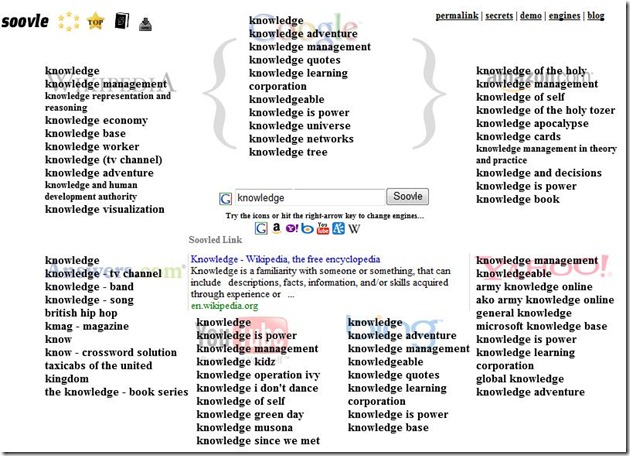
As can be seen, excepting several common terms (e.g. “knowledge”, “knowledge management”), the output for each engine it’s quite different. Because there is no visual aid, the extraction of common terms between engines it’s not so easy as it should be. Maybe something should be done in this direction – for example using colors, font weight or sorting.
When multi-term words are used (e.g. “data information knowledge wisdom”) the output becomes difficult to read, so maybe some styling would be useful in order to help determine the start/end of a group of terms.
Currently, the tool allows selecting a group of 7, 11, respectively 15 search engines. It would be useful to reduce maybe the number of search engines and increase the number of terms, allowing to compare the results for only 2-3 search engines. A matrix (terms vs. engines) could facilitate maybe the visualization of data.
As it seems the spaces influence the output, for example “DIKW” vs. “DIKW ” vs. “ DIKW” will return different results.
I really like the fact that by providing a first letter of the second term (e.g. “knowledge a”), the output can be limited only to the terms whose second terms start with the specified letters. (I needed this kind of functionality some time ago and I had to rely entirely on Google’s autocomplete feature.)
I was searching for my favorite quote from J. Keats “a thing of beauty is a joy forever” (with quotes). Unfortunately, none of the default 7 engines returned the quote, even if Bing’s result included some “joy”-related results. I tried the same search directly in Google and Bing, and matches were found?! Same result for “joy+forever”. Without some deeper knowledge of the architecture of the search engines and the tool itself, it’s hard to find what causes this behavior or to identify some of the differences in processing.
Comment: In the initial post it seems I misquoted Keats. I can't recall if then I used the misquoted chunk of text or the actual quote. Rechecking Soovle, it actually returns results for Google, YouTube and Bing.
Web x.0: Search Queries Tools ( Part I: Web Seer)
Since quite some time, Google provides an autocomplete feature extended to combinations of words. That’s quite an useful feature because often it “saved” my time from typing full words or combinations of words. What’s interesting is that the autocomplete algorithm provides the terms based on user’s search activities. I was asking myself if we could do more with search queries. This evening, while browsing, I discovered A. Smarty’s post on “How To Visualize and Play with Google Suggest Results”, in which she shortly presents three interesting tools: Web Seer, What do you suggest and Soovle. As I found out there are several other tools like Übersuggest, Quintura, etc. In this post I will focus only on Web Seer, following to review shortly several other similar tools in the next posts.
Web Seer allows users to compare the “matches” between two Google queries, for example “are man” vs. “are women”, “will he” vs. “will she”. To remain in blog’s thematic , I checked tool’s output for “data” vs. “information” and “information” vs. “knowledge”:

The query results for both terms are somehow predictable – “data mining”, “data warehouses”, “data entry” and “data values”, respectively “information architecture”, “information management”, “information security”, “information technology”, “information is beautiful” (see also the book) are quite popular terms in the scientific and non-scientific literature. I would expect the comparison is based on the most popular terms, because the two concepts don’t share many common terms, and even if there are some common terms within the above results (e.g. “data architecture”, “data systems”) they aren’t highly ranked. Arrows’ weight depicts the number of occurrences of the respective terms, which combined with the terms themselves, help to make an idea of the strength and resemblance existing between two concepts.
Climbing the DIKW scale here are the comparisons between information and “knowledge”, respectively “knowledge” and “wisdom”:

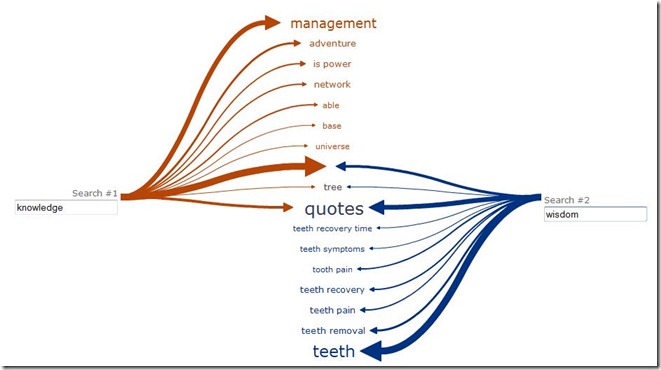
As it seems the results are consistent between relations, same combinations being used in two comparisons in which the same term is involved, life in the above diagrams. It’s natural that the results are also commutative, in order words “knowledge” vs. “information” renders same result as “information” vs. “knowledge”.
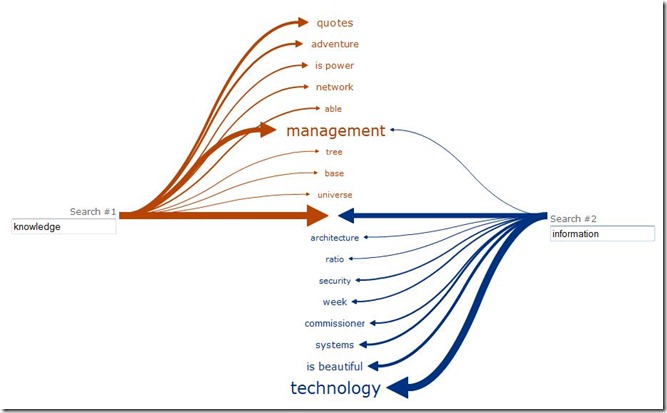
The association is also reflexive:
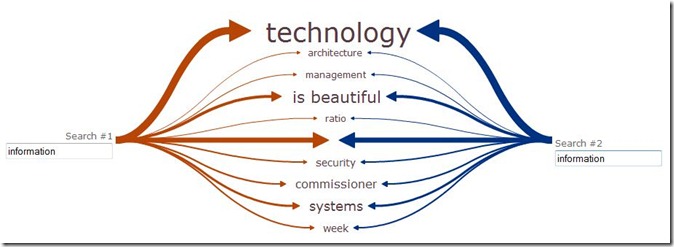
And transitive, as “data” vs. “information”, and “information” vs. “knowledge” lead to “data” vs. “knowledge”:

The algebraical operations are not so important, though some consistency of the results is needed between representations. It’s interesting that the comparison is influenced by a space placed at the beginning (e.g. “ data”) or end (“data ”), as can be seen in the following representation of the two:
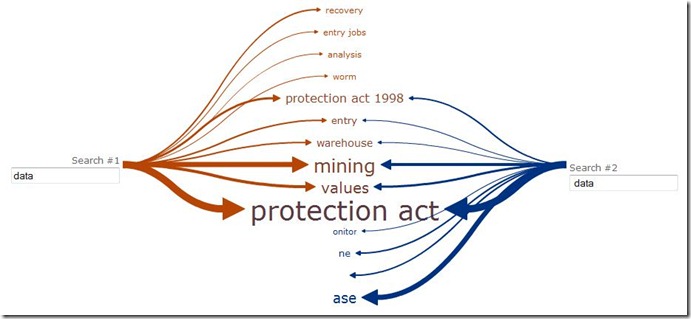
I would expect other similar signs (e.g. punctuation signs, special characters) influence the comparisons too. Talking about DIKW, the knowledge pyramid, let’s see the comparison between “DIKW” and “data information knowledge wisdom”:
As the two concepts have close semantics, “DIKW” is the acronym for “data information knowledge wisdom”, here’s the comparison between two synonyms: “distribution” vs. “diffusion” (like in distribution/diffusion of knowledge). As can be seen the association is stronger.
Actually the first attempt with the tool was a comparison “concept map” vs. “mind map”:
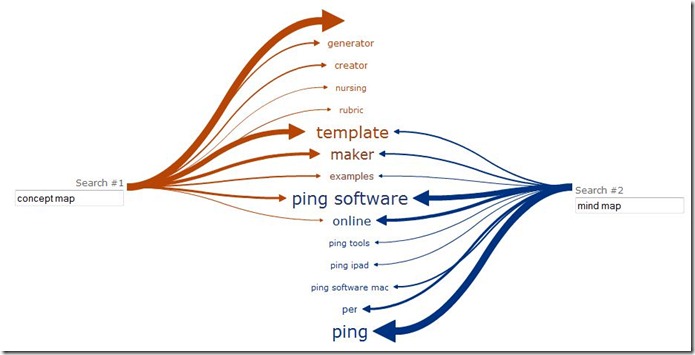
Which looks slightly different than “concept maps” vs. “mind maps” (so the plural form of words introduces variances):
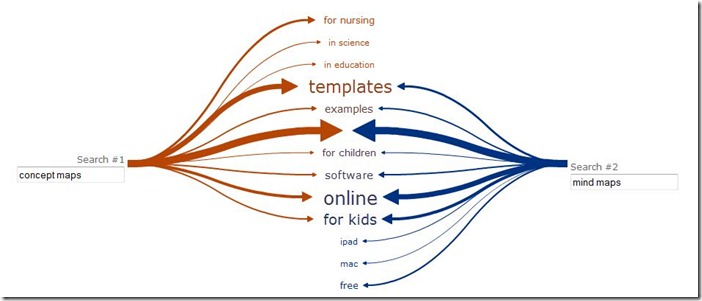
Considering the few examples run, the tool is quite intuitive and catchy. I would consider its utility as relative, even if the above examples are not representative and the relationships between them are more contextual. Still it’s a good tool for identifying automatically the relations/associations between concepts, to identify associations’ strength and maybe several semantic connotations. It would be interesting to see only the common terms, as many K-maps focus on this aspects, to introduce language and context, and the possibility to compare more than two terms (for example using Venn diagrams) or to show more/less common terms.
30 April 2011
Knowledge Representation: Weighted Categorization of 4 Knowledge Maps
| Content Type | Mind Maps | Conceptual Graphs | Ontology | Concept Maps | Weight | Notes |
| Methods | 2H, 2C | 2H, 2C | 4-5H, 2-3C | 3H, 3C | 2 | |
| Processes | 2H, 2C | 1H. 1C | 4H, 3C | 4H, 3C | 3 | |
| Experts | 5H, 2C | 3H, 3C | 5H, 2C | 5H, 2C | 3 | |
| Organizational subdivision | 5H, 1C | 1H, 3C | 5H , 1C | 5H, 1C | 2 | |
| Lessons Learned and experiences | 4H,1C | 3H, 4C | 3-4H, 1C | 5H, 2C | 3 | |
| Skill and Competencies | 5H, 2C | 3H, 2C | 5H, 2C | 5H, 2C | 3 | |
| Concepts | 4-5H, 3C | 3-4H, 3C | 5H, 3C | 5H, 3C | 5 | |
| Events | 4-5H, 3C | 3-4H, 3C | 5H, 3C | 5H, 3C | 4 | same as concepts |
| Patents | 2H, 1C | 2H, 1C | 3H, 1C | 3H, 1C | 2 | |
| Communication flow | 4-5H, 4C | 4-5H, 4C | 4-5H, 4C | 4-5H, 4C | 5 | |
| Interest or Knowledge needs | 4-5H, 2C | 4-5H, 2C | 4-5H, 2C | 4-5H, 2C | 4 | |
| Recipient Type | Mind Maps | Conceptual Graphs | Ontology | Concept Maps | Weight | Notes |
| Individual | 5 | 4 | 4 | 5 | 5 | |
| Team | 5 | 4 | 5 | 5 | 3 | |
| Organization And Networks | 5 | 3 | 5 | 5 | 3 | |
| Dyadic | 5 | 4 | 4 | 5 | 4 | same as individual |
| Departmental | 5 | 4 | 5 | 5 | 2 | same as team |
| Community | 5 | 3 | 5 | 5 | 3 | same as organization |
| Inter-Organization Maps | 5 | 3 | 5 | 5 | 2 | same as organization |
| Content Formats | Mind Maps | Conceptual Graphs | Ontology | Concept Maps | Weight | Notes |
| Websites | 5 | 3 | 4 | 5 | 3 | |
| Documents | 4 | 4 | 4 | 4 | 4 | |
| DataBases or Repositories | 5 | 5 | 5 | 5 | 5 | |
| Learning Object | 5 | 3 | 5 | 5 | 2 | |
| Online Courses | 3 | 1 | 3 | 3 | 3 | |
| Notes taking | 4 | 1 | 2 | 4 | 4 | |
| Layout | Mind Maps | Conceptual Graphs | Ontology | Concept Maps | Weight | Notes |
| Chained | 3 | 4 | 5 | 5 | 3 | |
| Clustered | 5 | 2 | 5 | 5 | 4 | |
| Hierarchical | 5 | 3 | 5 | 5 | 4 | |
| Radial | 5 | 1 | 4 | 5 | 3 | |
| Networked | 5 | 3 | 5 | 5 | 5 | |
| Creation Mode | Mind Maps | Conceptual Graphs | Ontology | Concept Maps | Weight | Notes |
| Manual | 5 | 3 | 4 | 5 | 5 | |
| Automated | 2 | 3 | 2 | 2 | 3 | |
| Semiautomated | 3 | 4 | 3 | 3 | 3 | |
| Collaborative | 5 | 4 | 5 | 5 | 4 | |
| Purpose Of KM Process | Mind Maps | Conceptual Graphs | Ontology | Concept Maps | Weight | Notes |
| Knowledge Creation | 5 | 2 | 4 | 5 | 3 | |
| Knowledge Assessment or audit | 5 | 3 | 4 | 5 | 4 | |
| Knowledge Identification | 5 | 4 | 5 | 5 | 4 | |
| Knowledge Development or Acquisition | 5 | 3 | 4 | 5 | 4 | |
| Knowledge Transfer | 5 | 2 | 4 | 5 | 5 | |
| Sharing Or Communication | 5 | 2 | 4 | 5 | 5 | |
| Knowledge Application | 4 | 3 | 5 | 4 | 3 | |
| Knowledge Marketing Maps | 4 | 2 | 2 | 3 | 2 | |
| Knowledge Type | Mind Maps | Conceptual Graphs | Ontology | Concept Maps | Weight | Notes |
| Know-What | 5 | 4 | 5 | 5 | 5 | |
| Know-Who | 5 | 4 | 5 | 5 | 5 | |
| Know-Why | 5 | 4 | 5 | 5 | 5 | |
| Know-Where | 5 | 4 | 5 | 5 | 5 | |
| Know-Who | 5 | 4 | 5 | 5 | 5 | |
| Visualization type | Mind Maps | Conceptual Graphs | Ontology | Concept Maps | Weight | Notes |
| Sketch | 3 | 1 | 2 | 4 | 4 | |
| Diagram | 3 | 1 | 2 | 3 | 3 | |
| Image | 3 | 1 | 2 | 3 | 2 | |
| Map | 2 | 1 | 2 | 2 | 2 | |
| Object | 1 | 1 | 2 | 2 | 3 | |
| Interactive Visualization | 3 | 1 | 3 | 3 | 4 | |
| Story | 3 | 2 | 2 | 3 | 4 | |
| Graphical Form | Mind Maps | Conceptual Graphs | Ontology | Concept Maps | Weight | Notes |
| Table | 2 | 2 | 3 | 3 | 3 | |
| Base Map | 3 | 3 | 3 | 3 | 3 | |
| Diagrammatic Maps | 3 | 3 | 3 | 3 | 3 | |
| Cartographic Maps | 3 | 1 | 4 | 3 | 2 | |
| Geographic Maps | 3 | 1 | 4 | 3 | 2 | |
| Heuristic Maps | 3 | 1 | 3 | 3 | 3 | |
| Metamorphic Maps | 2 | 2 | 3 | 3 | 4 | |
| Interactive Maps | 4 | 2 | 3 | 4 | 4 | |
| Mental Maps | 4 | 2 | 2 | 3 | 4 | |
| 3D Maps | 4 | 1 | 2 | 2 | 4 | |
| Function Type | Mind Maps | Conceptual Graphs | Ontology | Concept Maps | Weight | Notes |
| Coordination | 3 | 2 | 4 | 4 | 5 | |
| Attention | 3 | 1 | 2 | 3 | 4 | |
| Recall | 4 | 1 | 2 | 4 | 5 | |
| Motivation | 3 | 1 | 2 | 4 | 3 | |
| Elaboration | 4 | 2 | 4 | 4 | 5 | |
| New Insight | 4 | 3 | 4 | 4 | 5 | |
[1] Burkhard, R., Meier, M., Smis, M., Allemang, J., Honisch, L. (2005). Beyond Excel and Powerpoint: Knowledge Maps for the Transfer and Creation of Knowledge in Organizations. Proceedings of the 9th International Conference on Information Visualisation, p76-81. [Online] Available from: http://ieeexplore.ieee.org/Xplore/login.jsp?url=/ielx5/10086/32319/01509062.pdf?arnumber=1509062 (Accessed: 13 March 2009)
[2] Eppler, M.J. (2008). A Process-Based Classification of Knowledge Maps and Application Examples In: Knowledge and Process Management, Vol15, No1, p59–71. John Wiley & Sons. [Online] Available from: www.interscience.wiley.com (Accessed: 13 March 2009)
[3] Nastase, A. (2009). Utilizing Mind Maps as a Structure for Mining the Semantic Web. [Online] Available from: http://www.scribd.com/doc/16612282/Dissertation-paper-Utilizing-Mind-Maps-as-a-Structure-for-Mining-the-Semantic-Web (Accessed: 20 June 2009)

